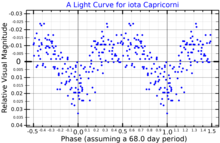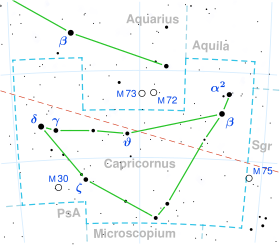Iota Capricorni
| Observation data Epoch J2000.0 Equinox J2000.0 (ICRS) | |
|---|---|
| Constellation | Capricornus |
| Right ascension | 21h 22m 14.79598s[1] |
| Declination | −16° 50′ 04.3580″[1] |
| Apparent magnitude (V) | +4.296[2] |
| Characteristics | |
| Spectral type | G8 III[3] |
| U−B color index | +0.63[2] |
| B−V color index | +0.89[2] |
| Variable type | BY Dra[4] |
| Astrometry | |
| Radial velocity (Rv) | +12.31±0.13[5] km/s |
| Proper motion (μ) | RA: 29.403±0.189 mas/yr[1] Dec.: 4.909±0.123 mas/yr[1] |
| Parallax (π) | 16.2048 ± 0.1688 mas[1] |
| Distance | 201 ± 2 ly (61.7 ± 0.6 pc) |
| Absolute magnitude (MV) | +0.18[6] |
| Details[5] | |
| Mass | 2.89±0.08 M☉ |
| Radius | 10.67±0.62 R☉ |
| Luminosity | 83 L☉ |
| Surface gravity (log g) | 3.05±0.10 cgs |
| Temperature | 5,200±28 K |
| Metallicity [Fe/H] | 0.05±0.05 dex |
| Rotation | 68 d[7] |
| Rotational velocity (v sin i) | 4.37±0.45 km/s |
| Age | 390 Myr |
| Other designations | |
| Database references | |
| SIMBAD | data |
Iota Capricorni (ι Cap, ι Capricorni) is a solitary,[9] yellow-hued star in the southern constellation of Capricornus. It can be seen with the naked eye, having an apparent visual magnitude of +4.3.[2] Based upon an annual parallax shift of 16.2 mas as seen from the Earth,[1] the star is located about 201 light years from the Sun. At that distance, the visual magnitude of the star is diminished by an extinction factor of 0.08 due to interstellar dust.[5]

This is an evolved G-type giant star with a stellar classification of G8 III.[3] It is classified as a BY Draconis type[4] variable star. This is a chromospherically-active star with a longitudinal magnetic field strength of 8.3±0.6 G and an X-ray luminosity of 4.482×1030 erg s−1.[7] The activity and photometric variation of the star allow an estimate of its rotation period as 68 days.[7]
Iota Capricorni has an estimated 2.9 times the mass of the Sun and nearly 11 times the Solar radius. It is 390 million years old and is radiating 83 times the solar luminosity from its chromosphere at an effective temperature of 5,200 K.[5]
Chinese name
[edit]In Chinese, 十二國 (Shíer Guó), meaning Twelve States, refers to an asterism which represents twelve ancient states in the Spring and Autumn period and the Warring States period, consisting of ι Capricorni, φ Capricorni, 38 Capricorni, 35 Capricorni, 36 Capricorni, χ Capricorni, θ Capricorni, 30 Capricorni, 33 Capricorni, ζ Capricorni, 19 Capricorni, 26 Capricorni, 27 Capricorni, 20 Capricorni, η Capricorni and 21 Capricorni.[11] Consequently, the Chinese name for ι Capricorni itself is 代一 (Dài yī, English: the First Star of Dai), meaning that this star (together with 37 Capricorni[12]) represents the state Dai (or Tae)(代).[13][14]
Planetary system
[edit]In 2022, two exoplanets, both super-Jovian in mass, were discovered in orbit around Iota Capricorni using a combination of radial velocity and astrometry. The inner planet has a highly eccentric orbit.[15]
| Companion (in order from star) |
Mass | Semimajor axis (AU) |
Orbital period (years) |
Eccentricity | Inclination | Radius |
|---|---|---|---|---|---|---|
| b | ≥3.480+0.589 −0.531 MJ |
1.771+0.056 −0.062 |
1.403+0.021 −0.022 |
0.732±0.049 | — | — |
| c | 7.485+3.395 −2.210 MJ |
5.067+0.204 −0.196 |
6.793+0.260 −0.226 |
0.202+0.125 −0.101 |
158.462+6.927 −9.058° |
— |
References
[edit]- ^ a b c d e Vallenari, A.; et al. (Gaia collaboration) (2023). "Gaia Data Release 3. Summary of the content and survey properties". Astronomy and Astrophysics. 674: A1. arXiv:2208.00211. Bibcode:2023A&A...674A...1G. doi:10.1051/0004-6361/202243940. S2CID 244398875. Gaia DR3 record for this source at VizieR.
- ^ a b c d Celis S., L. (October 1975), "Photoelectric photometry of late-type variable stars", Astronomy and Astrophysics Supplement Series, 22: 9–17, Bibcode:1975A&AS...22....9C.
- ^ a b Houk, N.; Smith-Moore, M. (1988), Michigan Catalogue of Two-dimensional Spectral Types for the HD Stars, vol. 4, Bibcode:1988mcts.book.....H.
- ^ a b Kazarovets, E. V.; Samus, N. N. (April 1997), "The 73rd Name-List of Variable Stars", Information Bulletin on Variable Stars, 4471 (4471): 1, Bibcode:1997IBVS.4471....1K.
- ^ a b c d Jofré, E.; et al. (2015), "Stellar parameters and chemical abundances of 223 evolved stars with and without planets", Astronomy & Astrophysics, 574: A50, arXiv:1410.6422, Bibcode:2015A&A...574A..50J, doi:10.1051/0004-6361/201424474, S2CID 53666931, A50.
- ^ Radick, Richard R.; et al. (September 1998), "Patterns of Variation among Sun-like Stars", The Astrophysical Journal Supplement Series, 118 (1): 239–258, Bibcode:1998ApJS..118..239R, doi:10.1086/313135.
- ^ a b c Aurière, M.; et al. (2015), "The magnetic fields at the surface of active single G-K giants", Astronomy & Astrophysics, 574: A90, arXiv:1411.6230, Bibcode:2015A&A...574A..90A, doi:10.1051/0004-6361/201424579, S2CID 118504829.
- ^ "iot Cap -- Variable of BY Dra type", SIMBAD Astronomical Database, Centre de Données astronomiques de Strasbourg, retrieved 2017-05-13.
- ^ Eggleton, P. P.; Tokovinin, A. A. (September 2008), "A catalogue of multiplicity among bright stellar systems", Monthly Notices of the Royal Astronomical Society, 389 (2): 869–879, arXiv:0806.2878, Bibcode:2008MNRAS.389..869E, doi:10.1111/j.1365-2966.2008.13596.x, S2CID 14878976.
- ^ Henry, Gregory W.; Fekel, Francis C.; Hall, Douglas S. (December 1995), "An Automated Search for Variability in Chromospherically Active Stars", Astronomical Journal, 110: 2926–2966, Bibcode:1995AJ....110.2926H, doi:10.1086/117740.
- ^ (in Chinese) 中國星座神話, written by 陳久金. Published by 台灣書房出版有限公司, 2005, ISBN 978-986-7332-25-7.
- ^ Iad Ridpath's Startales - Capricornus the Sea Goat
- ^ (in Chinese) AEEA (Activities of Exhibition and Education in Astronomy) 天文教育資訊網 2006 年 7 月 4 日 Archived 2011-05-22 at the Wayback Machine
- ^ Allen, Richard Hinckley (1963), "Capricornus", Star Names, Their Lore and Meaning, Dover, retrieved 2017-05-09.
- ^ a b Feng, Fabo; Butler, R. Paul; et al. (August 2022), "3D Selection of 167 Substellar Companions to Nearby Stars", The Astrophysical Journal Supplement Series, 262 (21): 21, arXiv:2208.12720, Bibcode:2022ApJS..262...21F, doi:10.3847/1538-4365/ac7e57, S2CID 251864022.

